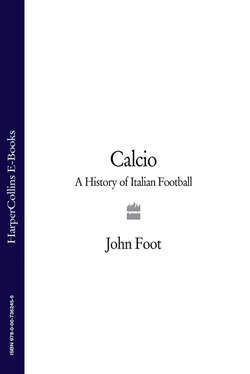Читать книгу Calcio: A History of Italian Football - John Foot - Страница 14
L’Italia. The National Team and the Reading Tour
ОглавлениеItaly’s national team began playing internationals in 1910, and the enthusiasm that surrounded them from the start was symptomatic of, and contributed to, the rapid growth of calcio after World War One. Yet, the early Italian teams were extremely weak in comparison with the major footballing nations of the time. Despite thrashing France and edging past Belgium, Italy were much less strong than Austria and Hungary. In the 1912 Olympics Italy lost to Finland and were crushed by Austria 5–1, although they managed to beat Sweden. With England, whom they did not meet at an international level until 1933, there was simply no comparison. Reading FC, a relatively minor club, toured Italy in May 1913. At the time, Reading had just finished eighth in the Southern League Division One.13
Reading took nearly two days to reach Genoa, where they thrashed the local team, 4–2. The next day it was the turn of Milan, who were dispatched 5–0, after Reading were four up within half an hour. Casale, who were to win the championship the following year, actually beat Reading, 2–1, but their pitch was so small that its width was close to that of a modern penalty area. On 15 May – their fourth match in five days – Reading bounced back. They destroyed Pro Vercelli – champions of Italy, and unbeaten for eighteen months – 6–0. On the following Sunday, in Turin, a match was organized between Italy and Reading. The English team won, 2–0, in front of 15,000 spectators. This was no scratch Italian team, but one with eight Vercelli players. Italy would take time to become a force on the world stage, but some talented players were emerging. Attilio Fresia of Genoa so impressed Reading that they signed him the following season, making him the first Italian to take part in professional football in England. He was not a success and moved on – to Clapham Common, for ten pounds – without ever making a first-team appearance. Reading’s Italian tour made an eighteen-pound profit.
Despite its low technical level the Italian team, almost from the start, attracted large crowds and provoked widespread interest in the game. Calcio as a mass game was created in part through the efforts and the popularity of the national team. Rapid progress was also made in coaching and training systems after World War One so that, by the 1920s, Italy was able to challenge for major honours on the world stage.
